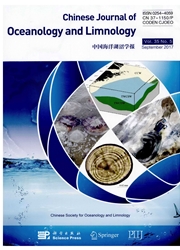

 中文摘要:
中文摘要:
牡蛎礁石有相等的、复杂 3-dimensional 结构到生长产地并且可以在河口环境提供类似的功能。不过,很少研究把牡蛎礁石与邻近的自然浅水的产地作比较。这里在一只人工的牡蛎(Crassostrea ariakensis ) 的居民 benthic macroinvertebrate 社区礁石并且在邻近的自然河口浅水的产地(盐沼, intertidal mudflat,和 subtidal 软底部) 在 Changjiang (Yangtze ) 河里,河口被描述。吝啬的全部的密度和生物资源, Margalefs 种类丰富, Pielous 平均和居民 benthic macroinvertebrate 社区的 Shannon 编织生物多样性索引在产地之中显著地不同。benthic macroinvertebrates 的显著地更高的密度和生物资源与另外的三个产地相比发生在牡蛎礁石。分类阴谋在四种产地类型之中在 benthic macroinvertebrate 社区显示出清楚的分离。结果证明人工的牡蛎礁石支持了不同、唯一的 benthic 社区,起在由供应猎物资源并且贡献生物多样性的复杂河口产地的一个重要作用。另外,结果建议牡蛎礁石成功地被恢复了。
 英文摘要:
英文摘要:
Oyster reefs have an equivalent, complex 3-dimensional structure to vegetated habitats and may provide similar functions in estuarine environments. Nevertheless, few studies have compared oyster reefs with adjacent natural shallow-water habitats. Here the resident benthic macroinvertebrate communities in an artificial oyster (Crassostrea ariakensis) reef and in adjacent natural estuarine shallow-water habitats (salt marsh, intertidal mudflat, and subtidal soft bottom) in the Changjiang (Yangtze) River estuary were described. The mean total densities and biomass, Margalef's species richness, Pielou's evenness and Shannon-Weaver biodiversity indices of the resident benthic macroinvertebrate communities differed significantly among the habitats. Significantly higher densities and biomass of benthic macroinvertebrates occurred in the oyster reef compared with the other three habitats. Ordination plots showed a clear separation in benthic macroinvertebrate communities among the four habitat types. The results demonstrated that the artificial oyster reef supported distinct and unique benthic communities, playing an important role in the complex estuarine habitat by supplying prey resources and contributing to biodiversity. In addition, the results suggested that the oyster reef had been restored successfully.
 同期刊论文项目
同期刊论文项目
 同项目期刊论文
同项目期刊论文
 Determination of Trophic Transfer at a Created Intertidal Oyster (Crassostrea ariakensis) Reef in th
Determination of Trophic Transfer at a Created Intertidal Oyster (Crassostrea ariakensis) Reef in th 期刊信息
期刊信息
